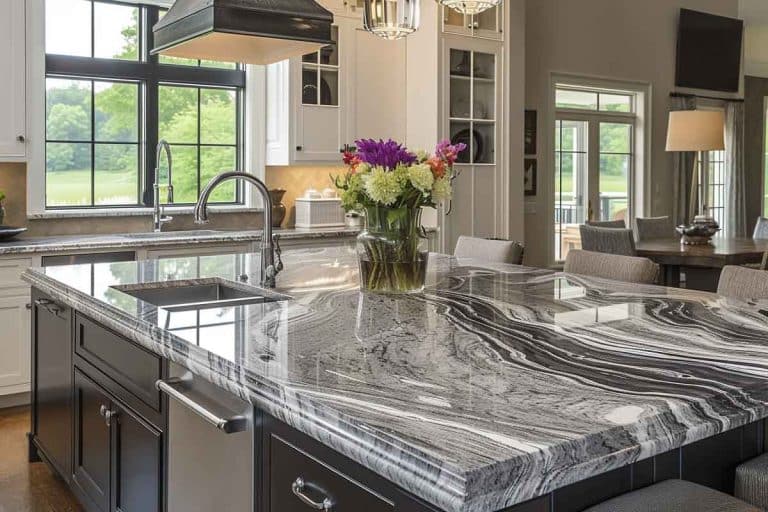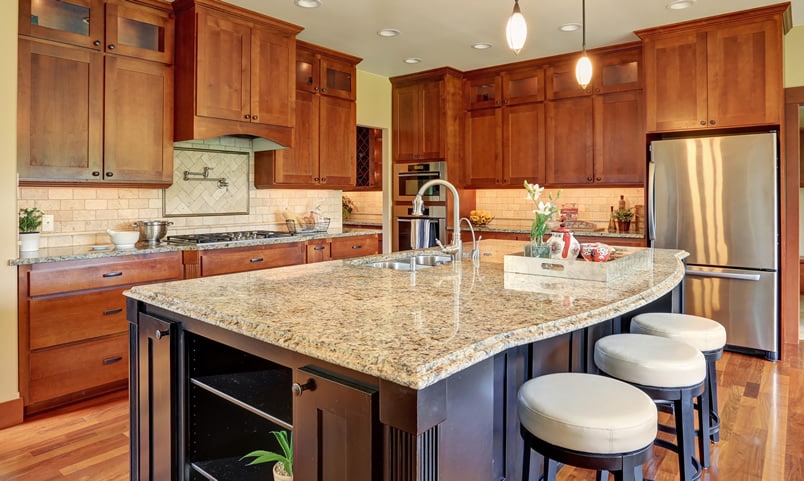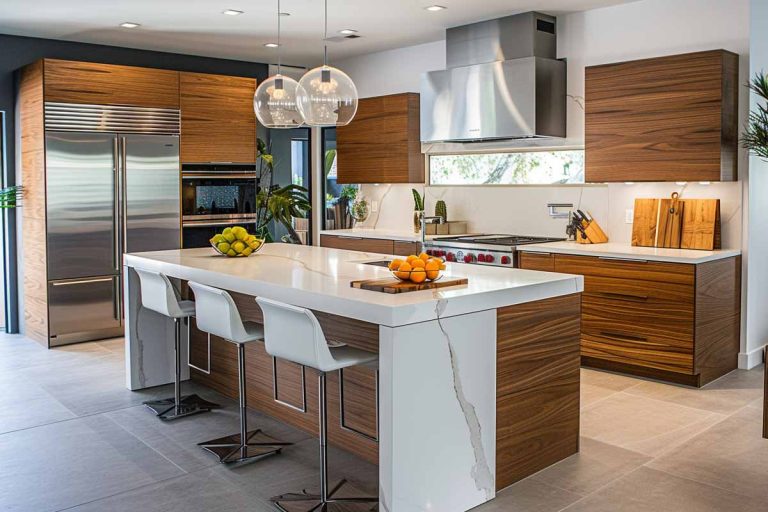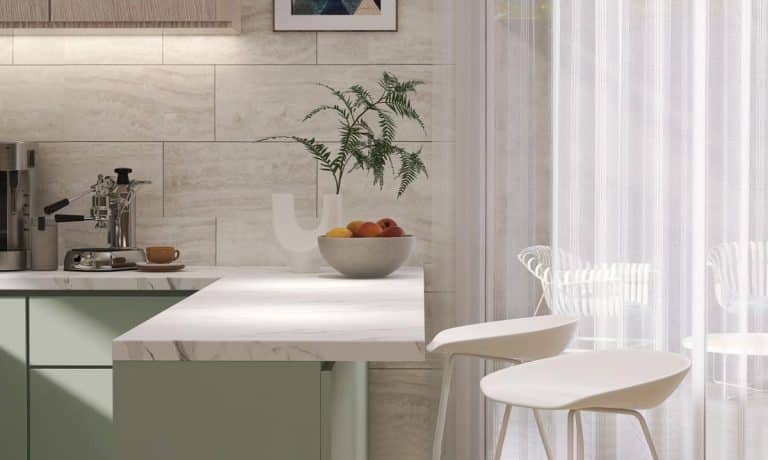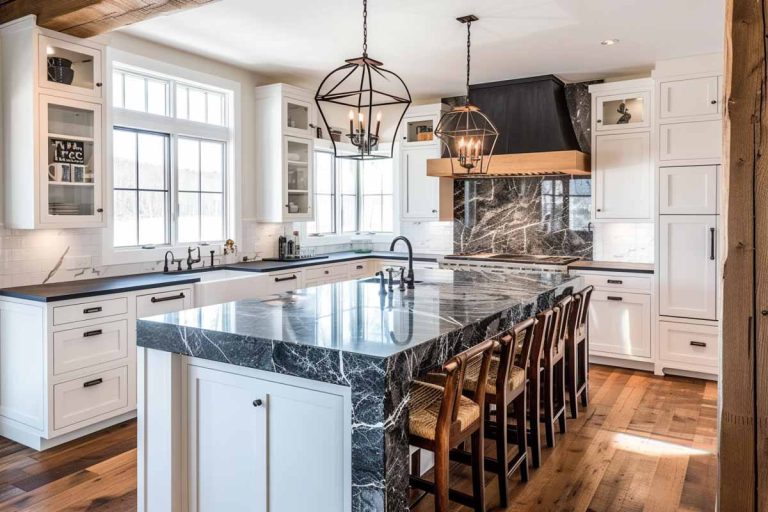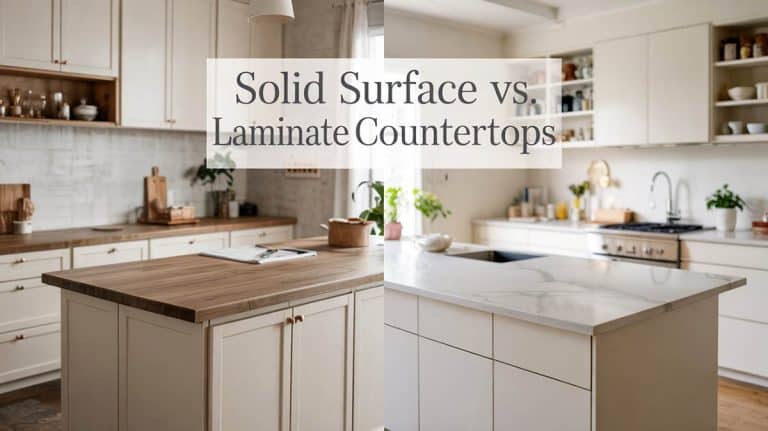Light Countertops vs. Dark Countertops: Which Fits Your Kitchen?
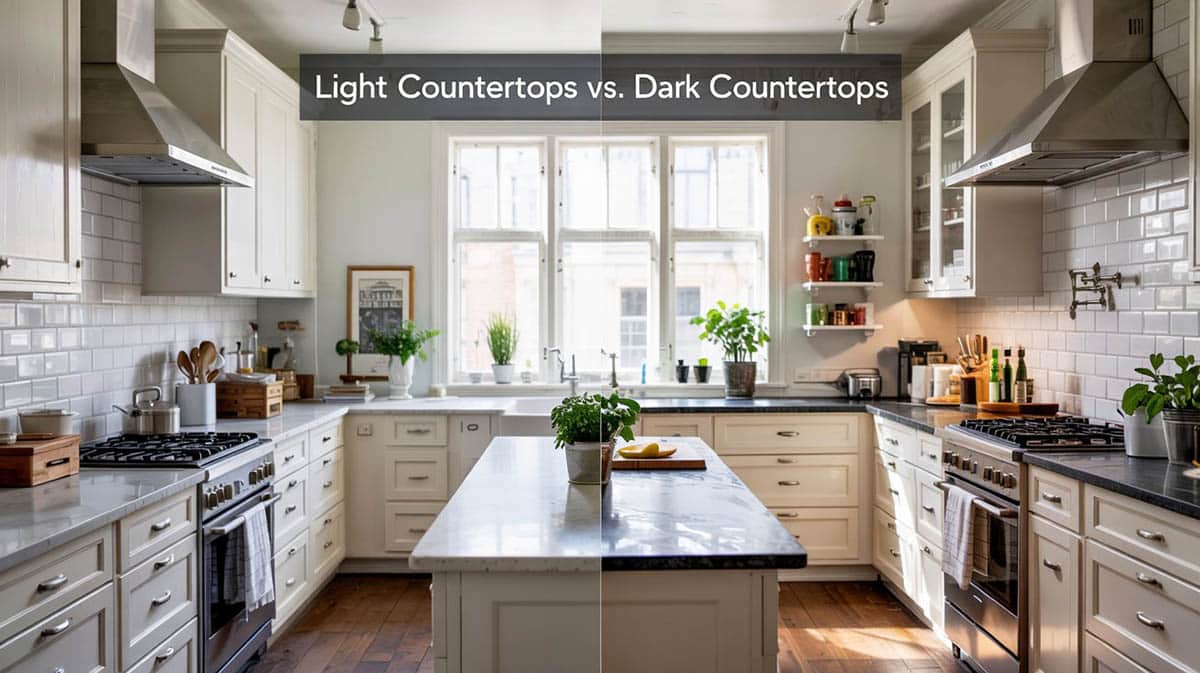
When you’re choosing between light and dark countertops, it’s really a choice between how you want your kitchen to feel day to day. Light surfaces will reflect more brightness and can enhance a smaller or low-light kitchen to make it feel larger. Dark surfaces, on the other hand, deliver drama and contrast, and can turn your counter into a focal point and really stand out when used in conjunction with white or pale cabinets. The downside is that these darker surfaces can visually compress a dimmer room and make it feel tighter. The right answer for your kitchen often depends less on the color and more on your windows, lighting, layout, and cabinetry, rather than the material itself.
TL;DR (Too Long, Didn’t Read Answer)
- Pick light countertops if you have a small kitchen, or want an airier feel, an easier way to hide scratches, and a more forgiving style for your mixed or darker cabinet colors.
- Pick dark countertops if you have a larger kitchen, or want a bold contrast, better camouflage for crumbs, or want to create a luxe, and dramatic focal point.
What Light and Dark Countertops Actually Mean
“Light” typically means any variety of hues of whites, creams, pale beiges, and soft grays with subtle veining. “Dark” covers shades like charcoals, espresso tones, and near-black stones like soapstone and varieties of black granite. You’ll frequently hear designers talk about Light Reflectance Value or LRV. It’s basically a scale of 0 (absolute black) to 100 (pure white), which simply means that the higher the number, the more they bounce light. In practice, lighter tops read brighter and more airy and forgiving, while darker tops feel richer and more custom-tailored. If your kitchen is small or doesn’t get that much daylight, homeowners will often choose light counters to keep the space from feeling closed in. However, if you’ve got big windows or strong lighting, you can go dark with confidence because the design has the level of brightness to support it.
The Big Differences Between Light And Dark Surfaces
Here’s a quick breakdown to give some of the ins and outs between the two choices.
Light Countertops
- Make small kitchens feel larger by bouncing light around.
- Their veins & speckles disguise micro-scratches.
- Will show coffee stains sooner, but the material and sealers make a difference.
- Pairs easily with wood tones and different color cabinets.
Dark Countertops
- Gives a dramatic contrast when paired with white cabinets.
- Reads more high-end in photos.
- Hides coffee splashes and little crumbs better.
- Can show dust, hard-water spots, and soap film more, especially on matte blacks.
- May visually shrink a very low-light room.
When To Choose Light Versus Dark Counters
| Scenario | Go Light Countertops If… | Go Dark Countertops If… | Notes |
|---|---|---|---|
| Small, low-light kitchen | You need to visually open the space | – | Use warm under-cabinet LEDs either way |
| Large, bright kitchen | You want airy, gallery-like calm | You want bold, high-contrast drama | Both work; consider cabinet color and flooring |
| Hate seeing crumbs & daily splashes |
– | Darker tops camouflage crumbs better | But dark shows dust and water spots near sinks |
| Worried about stains? | Pick non-porous light quartz | Dark quartz or dense granite also resists stains | Seal natural stone; use cutting boards |
| Traditional or coastal style | Creamy whites with soft veining | – | Brass or nickel hardware complements light palettes |
| Modern or industrial style | Pale concrete-look quartz | Charcoal/black, honed or leathered | Pair with black hardware and simple edges |
| Dark cabinets/wood tones | To balance and brighten the mass | For a moody, cocooned look | Ensure strong task lighting if going dark-on-dark |
| To maximize resale | Classic light quartzite/quartz veining | Timeless black or charcoal (not trendy colors) | Keep finishes neutral; avoid fads |
| Low maintenance is a priority | Polished light quartz; subtle pattern | Polished dark quartz; avoid ultra-matte near sinks | Matte can show rings; polished wipes faster |
How They Perform by Material
Here’s a quick breakdown of the different materials, whether they’re light/dark, and what you can expect from them day to day.
Quartz (engineered stone)
Both are excellent for their low maintenance and quick everyday cleanup.
- Light: Choose types with subtle marbling for a natural look.
- Dark: Select honed/velvet finishes to reduce glare, but expect to wipe away water spots.
Granite
Granite, when well sealed, is a low-maintenance choice that is often affordable and looks impressive.
- Light: Seal well to avoid potential stain absorption in lighter or more porous slabs.
- Dark: Dense black granites can look ultra-sleek and go with a variety of design styles.
Marble
This material generally needs extra care as it is more porous than others, like quartz and granite.
- Light: With its classic veining and patinas, it’s perfect for those who embrace character.
- Dark: Rarer tones are very rare and not widely available. Consider dolomite as a more durable “marble-look” alternative.
Quartzite
This material is formed from sandstone when under heat and pressure. It is generally more heat-resistant than quartz.
- Light: Offers a bright, crystalline look with a better etch resistance than marble.
- Dark: Less common, but can be stunning when found, and has a premium price.
Concrete
They can be a mid-range, affordable option that needs sealing and periodic maintenance.
- Light: Offers a modern, airy look.
- Dark: When stained a darker shade has an industrial vibe.
Butcher Block
These wood surfaces are higher maintenance than most and will need oiling and develop a patina.
- Light (maple, or birch): For a warm and bright look.
- Dark (walnut): Provides a rich tone, has scratches that blend nicely, but water rings can show.
Laminate
This option offers a budget-friendly price, and some styles provide a stone look. Go for seamless edges to improve realism.
- Light: Choose a matte surface to reduce glare.
- Dark: Use a convincing black soapstone for a “leathered” look.
Lighting, Room Size, and Cabinet Color
Here’s a quick checklist to help, depending on some elements like available lighting, room size, and current cabinetry.
- Low natural light and a small footprint: Go light to avoid the cave effect.
- Tons of daylight or lots of recessed cans/under-cabinet lighting for backlit surfaces: You can confidently go with dark counters.
- White or pastel cabinets: Both can work. Dark gives a high contrast, and light gives a serene monochromatic palette.
- Dark or wood cabinets: Light surface can balance the cabinet’s heaviness; dark-on-dark reads moody, but is great with metallic hardware and when there’s strong task lighting.
Cleaning Reality
- Light tops: Stains are the worry, so you’ll want to use cutting boards, wipe down promptly, and seal if you have a natural stone.
- Dark tops: Dust, limescale, and soap residue will show up faster. You’ll need to be proactive with your squeegee/wiping and drying around sinks. Consider a low-sheen finish to make these tasks easier.
Finish & Edge Profiles Matter
Honed/leathered finishes (light or dark) mute fingerprints and glare but can highlight water rings if not sealed. Polished surfaces are easiest to wipe clean but show reflections and smudges. If you have an island, always keep the finishes the same, for instance, both polished, honed, or leathered for a cohesive look.
Edge profiles should be eased or small radius for a modern and kid-friendly kitchen; ogee/bevel for a traditional feel; mitered waterfall for a contemporary statement that works with both light/dark styles.
Style Pairings
Modern/Minimal: Use a lighter shade with subtle gray veining or deep charcoal, a thin edge, and an integrated or undermount sink.
Transitional: Use a lighter marbled quartz or mid-gray quartzite with a beveled edge and brushed nickel or brass hardware.
Farmhouse/Coastal: Use a creamy quartz, lighter quartzite, or butcher block and pair with matte black or unlacquered brass hardware.
Industrial/Masculine: Use a dark concrete, black granite, or soapstone with a leathered finish and match with black hardware.
Resale Considerations
Light stones feel more market-friendly and tend to photograph beautifully in listings. Dark stones wow in high-contrast kitchens with the right lighting or windows. Choose timeless blacks and charcoals over trendy colors to keep the buyer appeal.
Budget Tips
Choose mid-priced light quartz with realistic veining for a bright, luxe look, for a more budget-friendly option. For dark drama on a budget, pick matte black laminate with a square profile and pair it with simple white shaker cabinets. Spend a little extra on under-cabinet lighting, as it instantly elevates any countertop.
Try-Before-You-Buy Checklist
Bring cabinet and floor samples to the slab yard/showroom to see how they pair together. Place samples under daylight and warm LEDs, and try to check their look in the morning and evening. Photograph the combo on your phone, as what looks good in person should also look good on your camera. Confirm the finish, edge, seam plan, and total price before purchasing.

